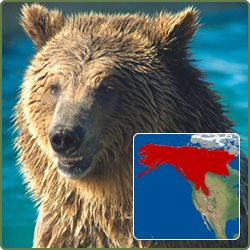Grizzly Bear List the Phylum, Class, Order, Family, Genus, and Species
Grizzly Bear
See Cypress (f), born Aug. 1st, 2007
 Classification:
Classification:
Kingdom: Animalia
Phylum: Chordata
Class: Mammalia
Order: Carnivora
Family unit: Ursidae
Genus: Ursus
Species: Ursus arctos
Subspecies: Ursus arctos horribilis
Personal Info:
Cypress came to Out of Africa Wildlife Park with her sister Aspen at just half dozen months of age from a taxidermist in Due north Carolina. Kept in a 10' 10 x' muzzle with concrete floors until rescued, she at present enjoys the space and stimulation she needs, including swimming and playing in the Wonders of Wild fauna show on most Saturdays. While her sister was more curious and loving, Cypress acts more similar a typical grizzly conduct. With a ii-acre habitat to romp around in, there's enough of room to satisfy the playful personality of Cypress. With a yearlong, steady diet forth with a mild and bearable winter (pun intended), Cypress does not hide. However, she does become a chip lethargic during the wintertime months.
Habitat:
The grizzly bear is known past many names: the silvertip bear, the grizzly, or the Due north American brown bear. It is a subspecies of the brown carry that mostly lives in the uplands of Western Northward America. The species is constitute in Alaska, south through much of Western Canada, and into portions of the Northwestern United States including Idaho, Montana, Washington, and Wyoming, extending as far south as Yellowstone and Grand Teton National Parks, but is almost commonly found in Canada.
Physical:
Nearly adult female grizzlies weigh 290 to 650 pounds, while adult males weigh on average 350 to 890 pounds.The boilerplate total length in this subspecies is 6 ½ anxiety with an average shoulder pinnacle of three ½ ft and hind-foot length of 11 inches. Surprisingly, newborn bears may counterbalance less than 1 pound. Although variable from blond to near black, grizzly carry fur is typically dark-brown in color with white tips. A pronounced hump appears on their shoulders; the hump is a good way to distinguish a black behave from a grizzly carry, as black bears practice not have this hump.
Life Bicycle:
The gestation catamenia of a grizzly is vi to 8 months, including a 5-month delayed implantation period. (Once mated with a male in the summer, the female delays embryo implantation until hibernation). The number of cubs born tin be betwixt 1 and 4, although 2 is more typical. The female parent cares for the cubs for upwardly to 2 years, during which time she will not mate. Sexual maturity is reached between 3 and 5 years. Once the immature leave or are killed, females may not produce another litter for 3 or more years, depending on ecology conditions. Because of these factors grizzly bears accept 1 of the lowest reproductive rates of all terrestrial mammals in North America.
Behavior:
These giants tend to be alone animals—with the exception of females and their cubs—only at times they practise besiege. Dramatic gatherings of grizzly bears tin can be seen at prime Alaskan fishing spots when the salmon run upstream for summer spawning. In this flavour, dozens of bears may assemble to feast on the fish, craving fats that volition sustain them through the long winter alee. Despite their impressive size, grizzlies are quite fast and have been clocked at 30 miles an hour. They can be dangerous to humans, specially if surprised or if humans come up between a mother and her cubs.
Diet:
Although grizzlies are of the society Carnivora and take the digestive system of carnivores, they are normally omnivores, since their diet consists of both plants and animals. They have been known to prey on big mammals when available, such as moose and deer. In coastal areas grizzly bears feed on salmon, trout, and bass. This protein-rich diet helps to produce larger Canadian or Alaskan grizzlies than those living in the interior. In Yellowstone National Park in the United States, the grizzly acquit's diet consists generally of white-bawl pine nuts, tubers, grasses, diverse rodents, army cutworm moths, and scavenged carcasses. None of these, notwithstanding, match the fat content of the salmon available in Alaska and British Columbia. In preparation for winter, bears tin can gain equally much as 400 pounds.
Fun Facts:
- The word grizzly in its name refers to "grizzled" or grey hairs in its fur.
- The grizzly deport appears on the flag of California, though they are extinct in the state, the last one having been shot in 1922.
- In some areas where food is plentiful year round, grizzly bears skip hibernation altogether, although they tend to be more lethargic in nature.
- During hibernation, a bear's middle charge per unit slows from upward to 70 beats per minute to only ten beats per infinitesimal. Their metabolism slows, and they exercise not urinate or defecate all wintertime! This "winter sleep" allows the bears to stay alive for a long period of time when there is piddling or no food bachelor to them.
- Bears in warmer climates spend less of their time curled up in their dens than those in an area with a longer wintertime.
Ecology and Conservation:
The grizzly bear has several relationships with its ecosystem. After consuming fruit-bearing plants, the seeds are dispersed and excreted in a germinated condition, deposited with nutrients in feces. This makes grizzly bears of import seed distributors in their habitats. While foraging for tree roots, institute bulbs, or ground squirrels, bears stir up the soil. This process not only helps grizzlies access their food but besides increases species richness in alpine ecosystems.
The grizzly conduct is listed as threatened in the contiguous United States and endangered in parts of Canada.
Source: https://outofafricapark.com/meet-the-animals/grizzly-bear-cypress/
0 Response to "Grizzly Bear List the Phylum, Class, Order, Family, Genus, and Species"
Postar um comentário